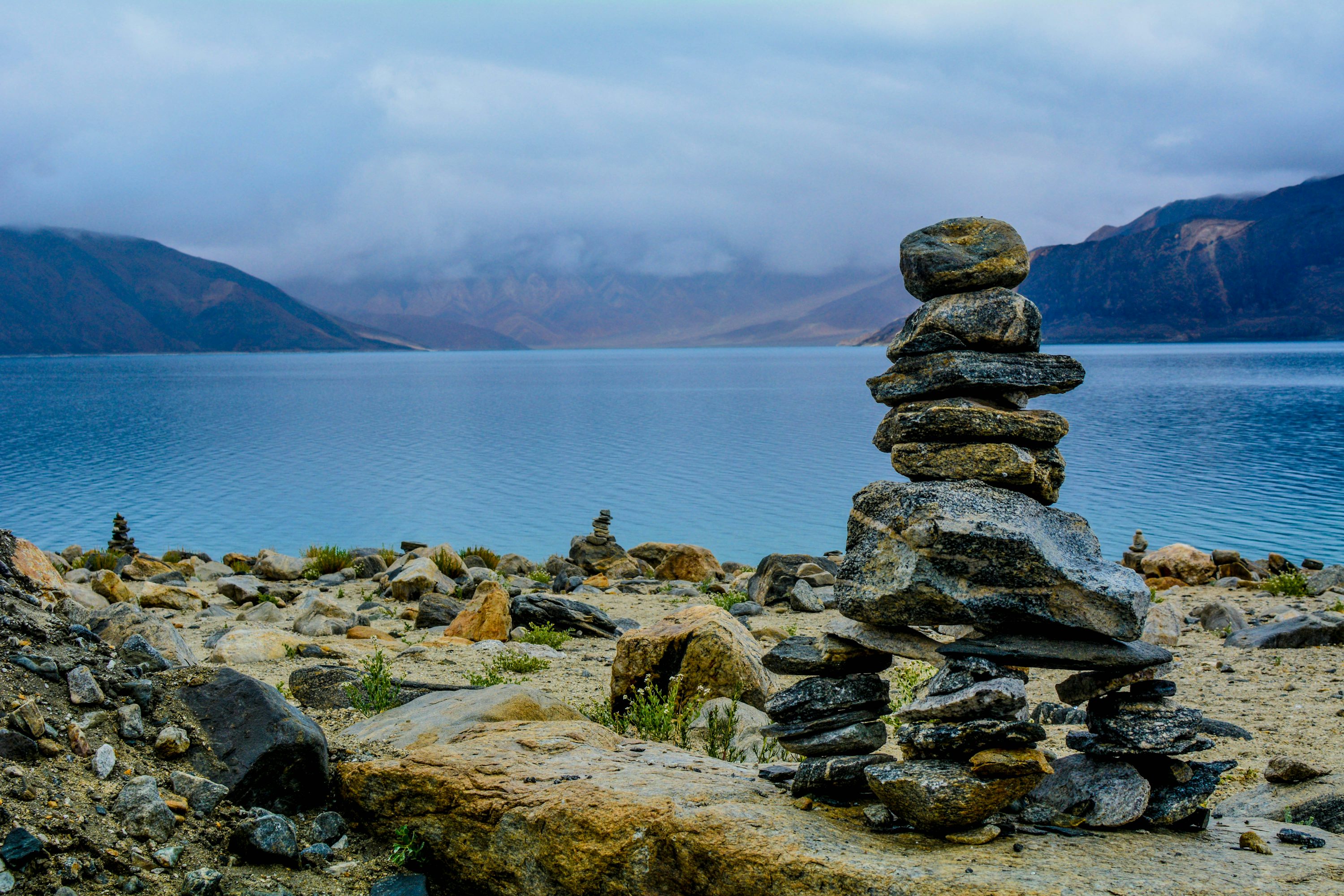
Pangong Lake, also known as Pangong Tso, is one of the most breathtaking natural wonders of Ladakh, stretching across India and into China. Situated at an altitude of about 4,350 meters, the lake is renowned for its ever-changing shades of blue, which shift dramatically with the sunlight. Covering around 134 kilometers in length, with one-third in India and the rest in China, Pangong is not just a visual delight but also a place of serenity and tranquility.
The journey to Pangong Lake is an adventure in itself, passing through high mountain passes like Chang La and offering stunning views of rugged landscapes, snow-capped peaks, and vast valleys. The lake’s crystal-clear waters reflect the surrounding mountains, creating picture-perfect moments for photographers and nature enthusiasts. Camping by the lake under a star-filled sky is one of the most magical experiences Ladakh has to offer.
Pangong gained massive fame after being featured in Bollywood movies, especially in the final scene of 3 Idiots, making it a bucket-list destination for travelers. Despite its beauty, the lake is a fragile ecosystem, and visitors are encouraged to preserve its pristine charm by avoiding littering and respecting the environment.
During winter, Pangong Lake completely freezes despite its saline water content, turning into a surreal sheet of ice. In summer, migratory birds like seagulls and Brahminy ducks visit its shores, adding to its charm. Whether visited for adventure, photography, or sheer peace, Pangong Lake never fails to leave visitors spellbound.
Best time to visit: May–September
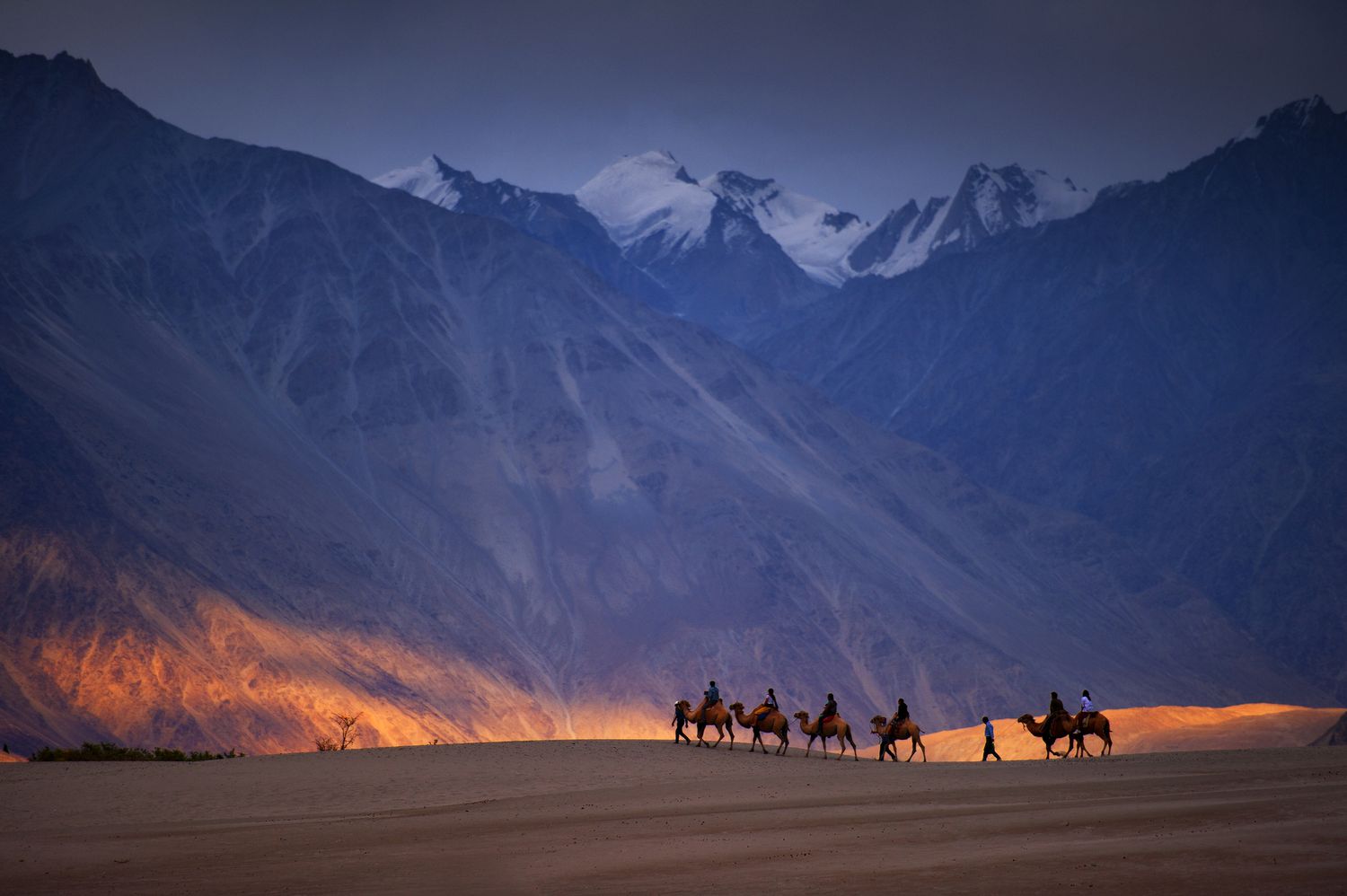
Nubra Valley, often called the “Orchard of Ladakh,” is a unique blend of lush green villages, barren mountains, and vast cold deserts. Located about 150 kilometers from Leh, the valley lies at an average altitude of 10,000 feet and is famous for its breathtaking landscapes. The Shyok and Nubra rivers flow through this valley, creating fertile land amidst the high-altitude desert terrain.
One of the main attractions of Nubra Valley is the sand dunes of Hunder, where visitors can enjoy a rare experience—camel rides on double-humped Bactrian camels. These camels are remnants of the ancient Silk Route trade, which once passed through this region. The Diskit Monastery, with its giant Maitreya Buddha statue overlooking the valley, offers panoramic views and spiritual calm.
Nubra Valley is also known for its picturesque villages like Turtuk, which is the last village on the Indian side before the Pakistan border. The blend of Ladakhi and Balti cultures here adds a unique charm to the region. The valley’s apricot orchards and vibrant fields stand in stark contrast to the surrounding barren mountains, making it a photographer’s paradise.
Travelers reach Nubra Valley by crossing the world-famous Khardung La Pass, one of the highest motorable roads in the world. The journey is as mesmerizing as the destination, offering views of snow peaks and winding roads. Camping under the starry skies of Nubra is an unforgettable experience for adventurers and nature lovers alike.
Best time to visit: June–September

Khardung La, perched at an altitude of around 18,000 feet, is one of the highest motorable mountain passes in the world. Located in the Ladakh region, it serves as the gateway to the Nubra and Shyok Valleys. The pass holds strategic importance for the Indian Army, as it provides access to the Siachen Glacier, the world’s highest battlefield.
Riding or driving to Khardung La is an exhilarating experience, with winding roads, snow-covered peaks, and breathtaking Himalayan views. The thin air and extreme altitude make it a challenging journey, so visitors are advised to acclimatize properly before attempting the ascent. The pass is often draped in snow even during summer, making it a surreal spot for photography.
Apart from its natural beauty, Khardung La has become a symbol of adventure for bikers and travelers from across the globe. The journey offers a mix of thrill and tranquility, with prayer flags fluttering in the wind and the crisp mountain air adding to the charm. On a clear day, the view from the top is absolutely mesmerizing, with snow peaks stretching into the horizon.
Reaching Khardung La from Leh is a scenic drive of about 39 kilometers, but the altitude and winding roads make it feel like a true expedition. For many adventurers, conquering Khardung La is a badge of honor and a lifetime memory.
Best time to visit: May–September
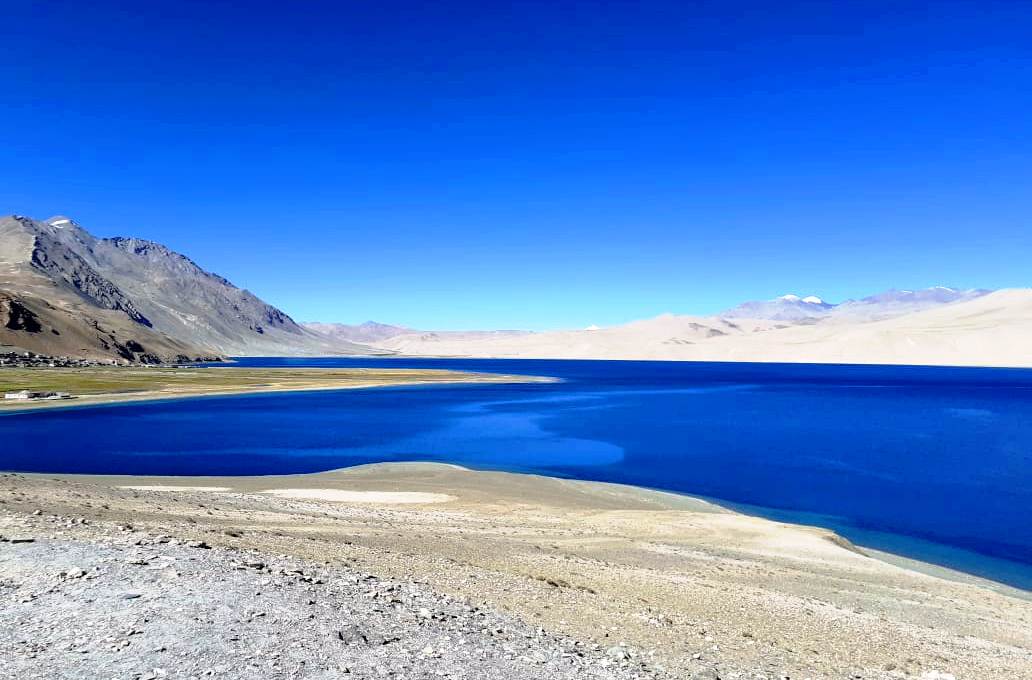
Tso Moriri Lake, situated at an altitude of around 15,075 feet in the Changthang region of Ladakh, is a breathtaking high-altitude lake surrounded by rugged mountains. Known for its serene beauty, the lake reflects the clear blue sky, creating an otherworldly landscape that feels untouched by time. It is part of the Tso Moriri Wetland Conservation Reserve, making it an important site for migratory birds.
The lake is about 29 kilometers long and 8 kilometers wide, with crystal-clear water that changes shades with the movement of the sun. Its remote location ensures minimal human interference, allowing travelers to experience raw natural beauty. Wildlife enthusiasts can also spot rare species like the black-necked crane, bar-headed geese, and Tibetan wild ass (Kiang) in the surrounding areas.
Camps and homestays near Korzok village provide basic accommodation, giving visitors a chance to immerse themselves in the peaceful environment. The reflection of snow-covered peaks in the lake during sunrise and sunset is a sight that stays etched in memory forever.
Reaching Tso Moriri requires a long drive from Leh through rugged terrains, but the journey offers spectacular views of Ladakh’s barren yet beautiful landscape. Due to the high altitude, proper acclimatization is essential to avoid altitude sickness.
Best time to visit: June–September

Magnetic Hill, located about 30 km from Leh on the Leh–Kargil–Baltic National Highway, is one of Ladakh’s most famous and intriguing attractions. It is known for a unique optical illusion where vehicles, when left out of gear, appear to roll uphill against gravity. This phenomenon has fascinated travelers for years, sparking both scientific explanations and mystical stories.
The surrounding barren mountains and winding roads create a surreal backdrop that adds to the hill’s charm. Many believe local legends that speak of it being a “road to heaven,” where those deemed worthy are pulled upwards. Scientists, however, explain it as a gravity hill effect caused by the layout of the land, which tricks the eyes into seeing a slope where there is actually a downhill gradient.
Visitors often stop here to test the phenomenon themselves, letting their vehicles roll seemingly uphill while capturing photos and videos. The area also offers scenic views of Ladakh’s rugged beauty, making it a great spot for a quick break on the way to or from Leh.
Being on the main highway, Magnetic Hill is easily accessible and is often included in Ladakh road trip itineraries. The experience, whether believed to be magical or scientific, leaves a lasting impression.
Best time to visit: May–October
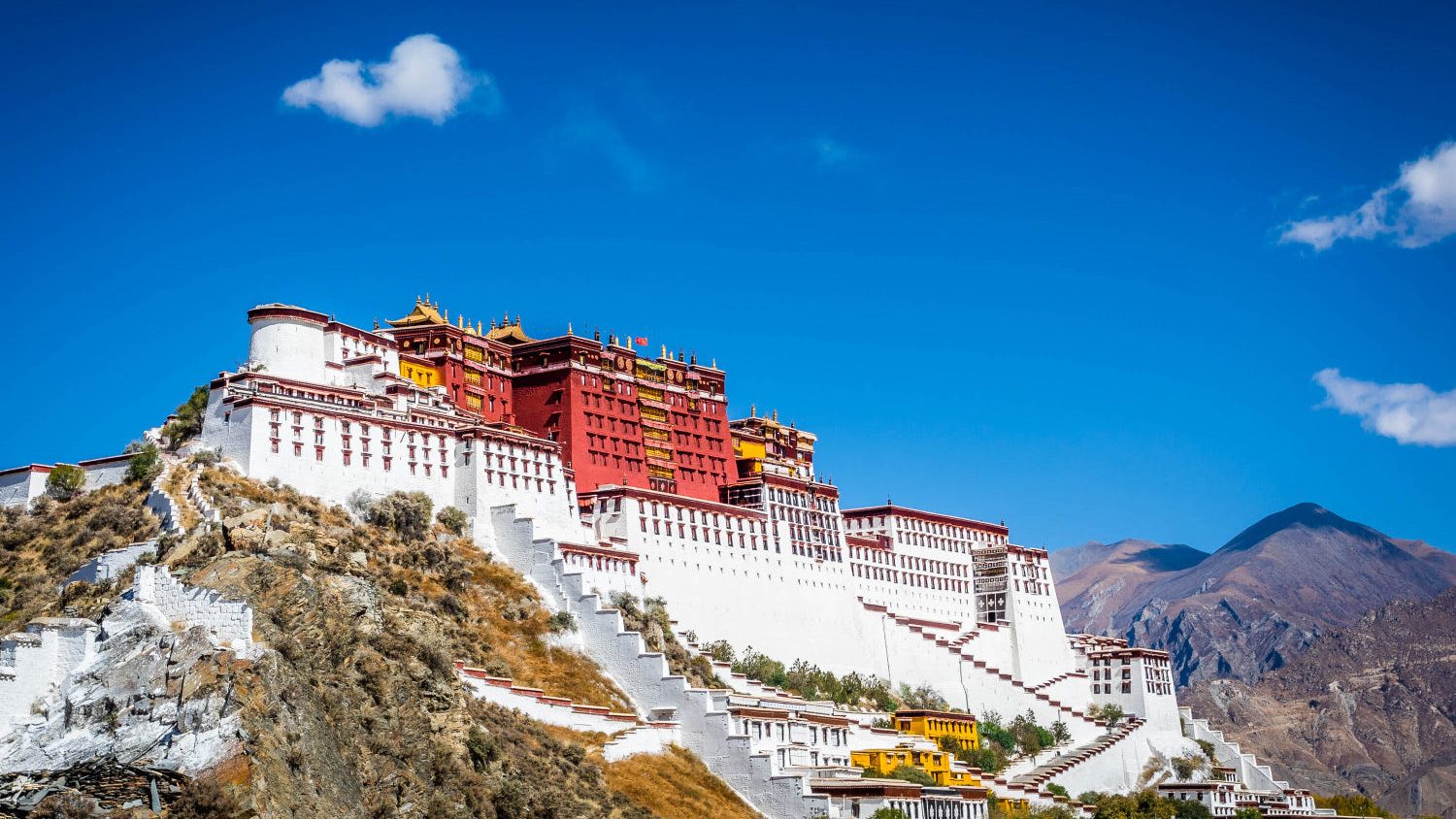
Leh Palace, perched on a hilltop overlooking the town of Leh, is a nine-story marvel built in the 17th century by King Sengge Namgyal. Resembling the Potala Palace of Lhasa in Tibet, this architectural wonder was once the royal residence of the Namgyal dynasty. From its balconies and rooftops, visitors are treated to panoramic views of the Stok Kangri mountain range, the Indus Valley, and the bustling town below.
Inside, the palace houses a museum that displays a fascinating collection of jewelry, ceremonial dresses, crowns, ancient paintings, and Tibetan thangkas, some over 400 years old. The walls, though worn by time, still hold the charm of Ladakh’s regal history. Wandering through the dimly lit corridors and wooden staircases feels like stepping back into the royal era.
The palace is also a cultural hub during festivals, with vibrant traditional performances and exhibitions bringing its stone walls to life. Its location offers a perfect blend of heritage exploration and breathtaking photography opportunities.
Today, Leh Palace is managed by the Archaeological Survey of India and continues to stand as a proud symbol of Ladakh’s rich history and Tibetan-influenced architecture.
Best time to visit: May–September
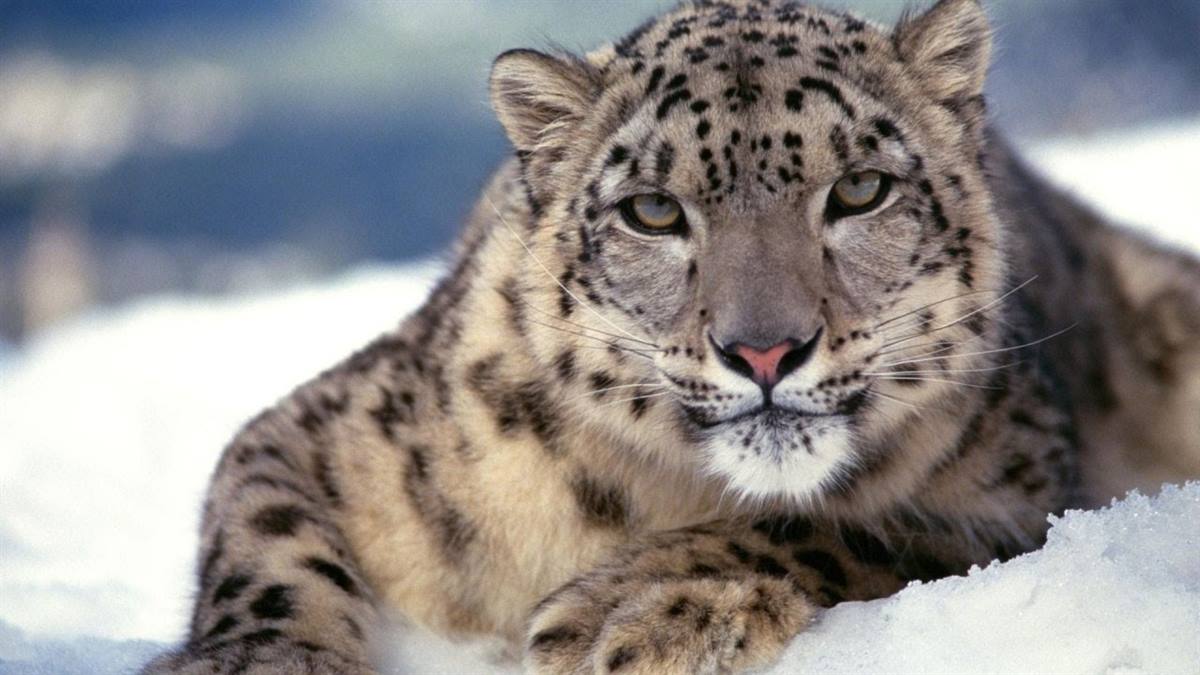
Hemis National Park, nestled in the eastern Ladakh region of Jammu and Kashmir, is India’s largest national park and one of the world’s highest-altitude protected areas. Spanning over 4,400 sq km, it is famed as the home of the elusive snow leopard, earning it the title "Snow Leopard Capital of the World." The park’s rugged landscapes, high-altitude grasslands, and alpine meadows offer a surreal blend of raw beauty and wild adventure.
Apart from snow leopards, Hemis shelters unique wildlife like the Tibetan wolf, Eurasian brown bear, red fox, and blue sheep (bharal). Birdwatchers can also spot golden eagles, lammergeiers, and Himalayan griffon vultures soaring high above the valleys. The park’s diverse terrain ranges from rocky cliffs to serene river valleys, making every trek an exhilarating experience.
Hemis National Park is also culturally significant, housing the famous Hemis Monastery, a centuries-old Buddhist site that hosts the colorful Hemis Festival every June. Visiting during the festival offers a rare blend of wildlife exploration and deep-rooted cultural immersion. The park is accessible from Leh, and guided treks are available for those looking to explore its remote beauty.
For adventure lovers, winter expeditions in search of snow leopards are a major draw, though they require endurance and expert guidance due to extreme weather.
Best time to visit: May–September
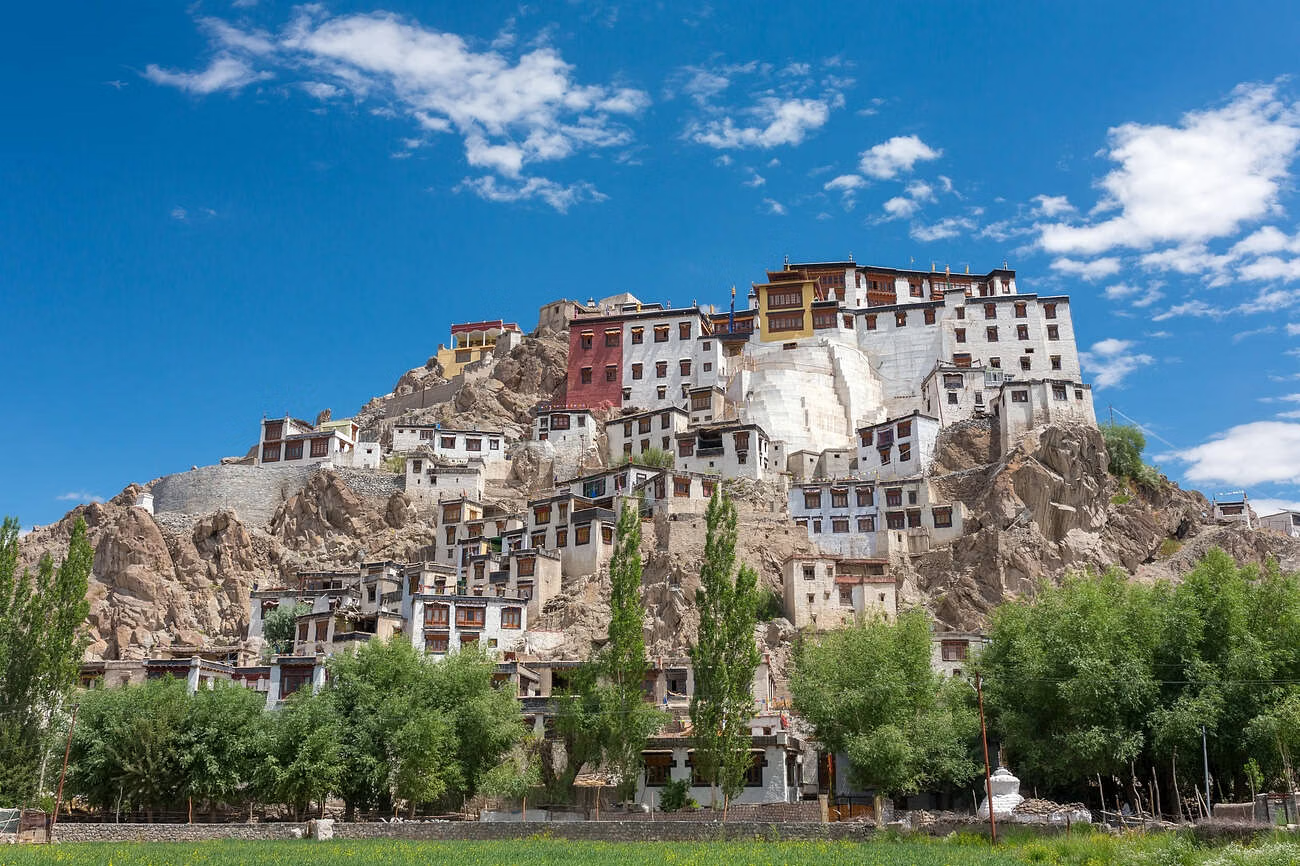
Spituk Monastery, perched on a hilltop overlooking the Indus River, is one of Ladakh’s most revered Buddhist sites. Founded in the 11th century by Od-de, the elder brother of the famous translator Lotsava Rinchen Zangpo, it is a treasure trove of ancient thangkas, statues, and sacred relics. Its name, Spituk, meaning “exemplary,” reflects the monastery’s reputation as a center of spiritual learning and meditation.
The monastery follows the Gelugpa (Yellow Hat) sect of Tibetan Buddhism and houses around 100 monks. Inside, visitors can explore prayer halls adorned with colorful murals and life-sized guardian deities. A highlight is the sacred image of Mahakala, the fierce protector deity, which is unveiled to the public only during the annual Gustor Festival.
From its vantage point, Spituk offers sweeping views of the rugged mountains, the meandering Indus, and the distant snow peaks — making it not just a spiritual stop, but also a visual delight for photographers and travelers.
If you visit during the Spituk Gustor Festival, held every January, you can witness masked cham dances, traditional music, and deep-rooted Himalayan Buddhist rituals that bring the monastery to life.
Best time to visit: May–September
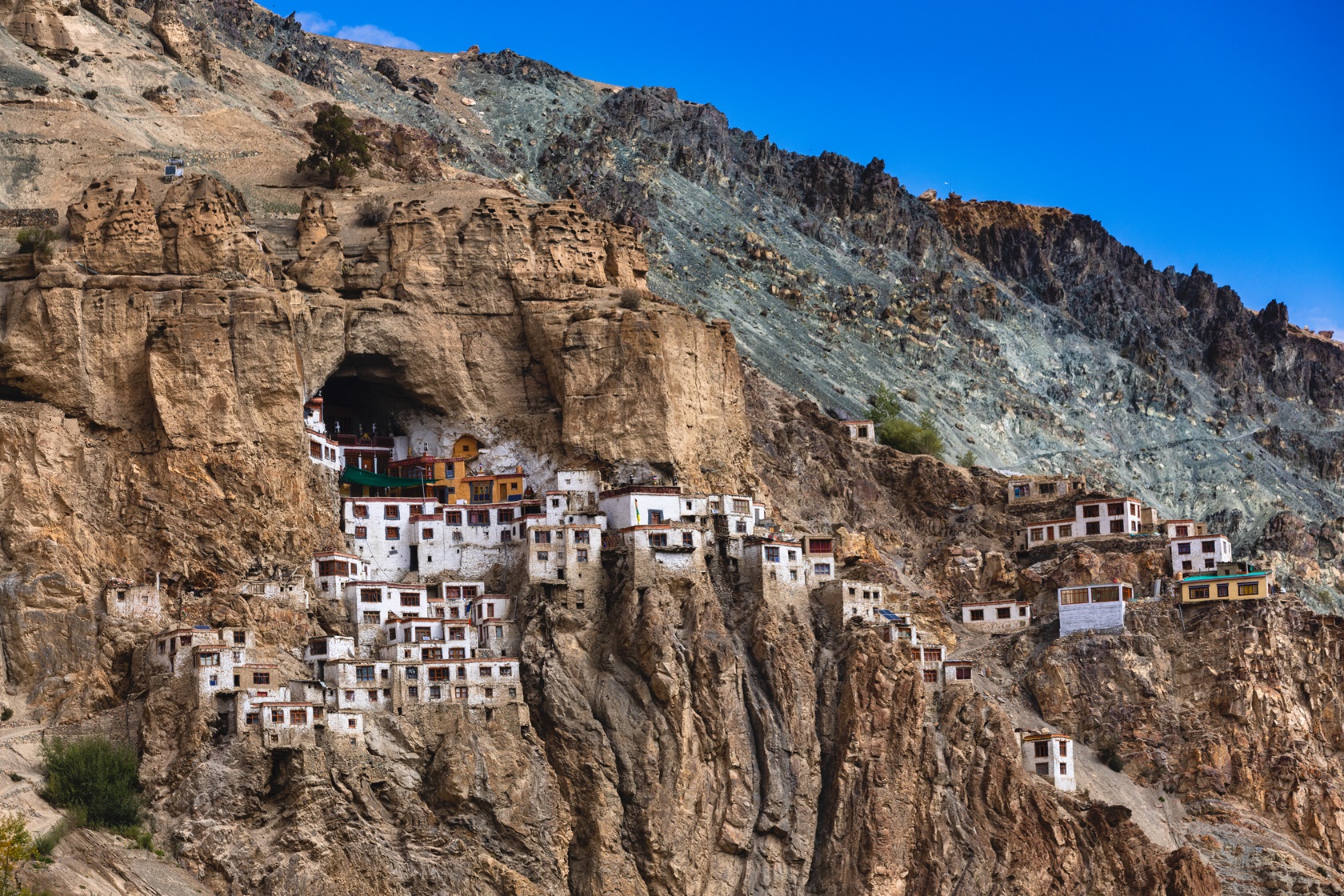
Phuktal Monastery, one of the most remote and breathtaking gompas in Ladakh’s Zanskar Valley, seems like something straight out of a dream. Built into the mouth of a natural limestone cave on a sheer cliffside, it appears to grow organically from the mountain itself. The monastery’s name, Phuktal, comes from the Zanskari word for “cave,” reflecting its origins as a retreat for sages and scholars long before the gompa was formally established in the early 15th century by Lama Gangsem Sherap Sampo, a disciple of the renowned Je Tsongkhapa.
The monastery is home to a sacred spring inside the cave whose water is believed to have healing properties and flows steadily year-round, regardless of the harsh Himalayan winters. The cave’s main assembly hall, adorned with ancient murals, serves as a space for prayer, meditation, and teaching for the resident monks.
Reaching Phuktal is an adventure in itself — there are no motorable roads leading to it. Travelers must trek through rugged mountain paths and cross wooden suspension bridges over the turquoise Tsarap River, making the journey as memorable as the destination.
This hidden sanctuary radiates an air of peace and timelessness, offering visitors a rare glimpse into the unaltered spiritual traditions of Tibetan Buddhism in one of the most isolated corners of India.
Best time to visit: June–September
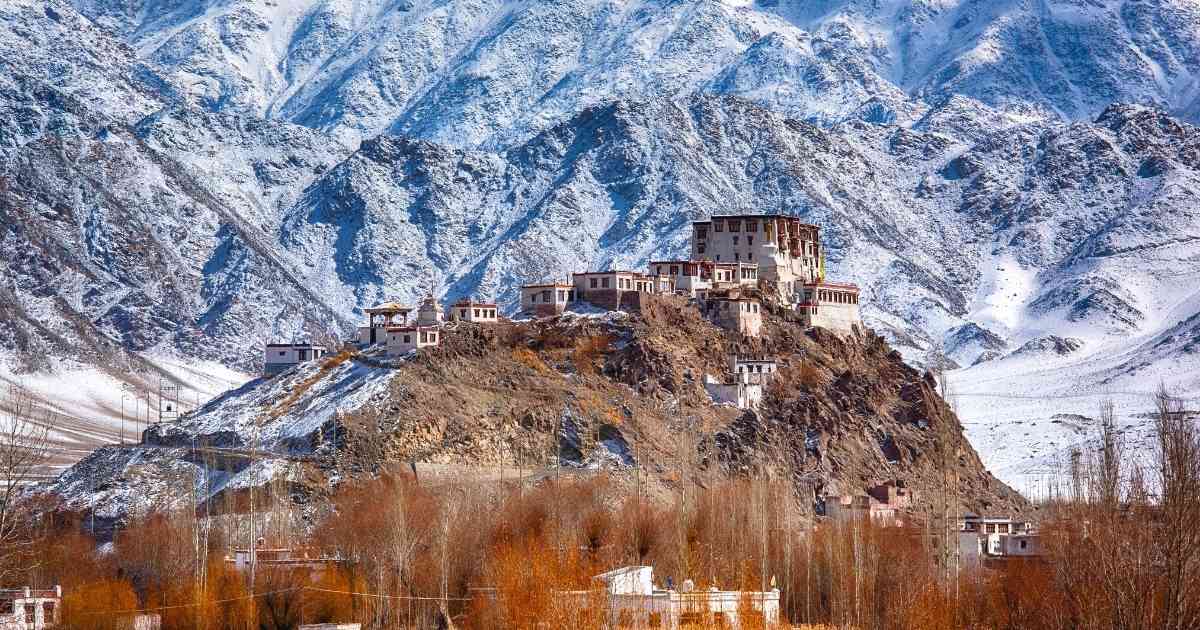
Stakna Monastery, perched dramatically on a rocky hill along the banks of the Indus River, is one of Ladakh’s most picturesque and spiritually significant gompas. Its name, Stakna, means “Tiger’s Nose” in Ladakhi, inspired by the hill’s striking resemblance to the shape of a tiger’s snout. Founded in the late 16th century by the Bhutanese scholar and saint Chosje Jamyang Palkar, it belongs to the Drukpa sect of Tibetan Buddhism.
The monastery is renowned for its main assembly hall, where intricate thangkas (Tibetan Buddhist paintings) and vivid murals depict deities and scenes from Buddhist scriptures. The serene whitewashed structures contrast beautifully with the surrounding golden mountains and deep blue skies, making it a photographer’s delight.
From its rooftop, visitors are treated to breathtaking panoramic views of the Indus Valley, the lush riverbanks, and distant snow-clad peaks. Unlike some of the busier gompas, Stakna retains a peaceful, almost meditative atmosphere, making it ideal for travelers seeking quiet reflection.
Visiting Stakna offers not only a spiritual experience but also a chance to immerse oneself in the raw beauty of Ladakh’s landscape.
Best time to visit: June–September
